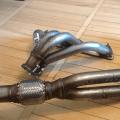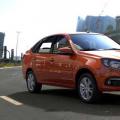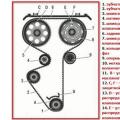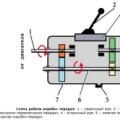Krasnodar Humanitarian and Technological College
Considered at a meeting Approved
department of General Humanities Deputy Director for OIA
and natural sciences ____________ G.A. Slovtsova
Head of Department _________ T.S.Yatsenko "____" __________ 20__
"___" __________________ 20__
Test options
In the discipline "Electrical Engineering and Electronics"
For specialties: " Maintenance and repair
Automobile transport "
"Woodworking technology"
Compiled by:
Teacher of KGTK
T.S.Yatsenko.
Krasnodar 2010
Section 1 "Direct electric current"
1. Determine the resistance of the incandescent lamp, if it says 100 W and 220 V
a) 484 Ohm b) 486 Ohm
c) 684 Ohm d) 864 Ohm
2. Which of the wires of the same diameter and length heats up more strongly - copper or steel at the same current strength?
a) Copper b) Steel
c) Both wires get hot d) None of the wires
Doesn't heat up equally
3.How will the voltage at the input terminals of the electrical circuit change direct current with an active element, if one more element is included in parallel with the original?
a) Will not change b) Will decrease
c) Increase d) Not enough data to answer
4. In the DC electrical network, the voltage at the terminals of the power source is 26 V. The voltage at the terminals of the consumer is 25 V. Determine the voltage loss at the terminals in percent.
a) 1% b) 2%
c) 3% d) 4%
5. The electrical resistance of the human body is 3000 ohms. What current passes through it if a person is energized at 380 V?
a) 19 mA b) 13 mA
c) 20 mA d) 50 mA
6. Which of the wires of the same length, made of the same material, but of different diameters, heats up more at the same current?
A) Both wires heat up equally;
B) The wire with a large diameter heats up more;
B) The wire with a smaller diameter heats up more;
D) Conductors do not heat up;
7. What wires combine high mechanical strength with good electrical conductivity?
a) In steel b) In aluminum
c) In steel-aluminum d) In copper
8. Determine the total resistance of the circuit with parallel connection of consumers, the resistance of which is 10 Ohm?
a) 20 Ohm b) 5 Ohm
c) 10 ohm d) 0.2 ohm
9. Two sources have the same EMF and currents, but different internal resistances. Which source has the highest efficiency?
a) The efficiency of the sources is equal.
b) A source with a lower internal resistance.
c) A source with high internal resistance.
d) Internal resistance does not affect efficiency.
10.In electrical diagram two resistive elements are connected in series. What is the input voltage at 0.1 A if R1 \u003d 100 Ohm; R 2 \u003d 200 Ohm?
a) 10 V b) 300 V
c) 3 V d) 30 V
11. Which of the following properties does not correspond to the parallel connection of branches?
a) The voltage on all branches of the circuit is the same.
b) The current in all branches is the same.
c) The total resistance is equal to the sum of the resistances of all branches of the circuit
d) The ratio of currents is inversely proportional to the ratio of resistances on the branches of the circuit.
12. What devices are capable of measuring voltage in an electrical circuit?
a) Ammeters b) Wattmeters
c) Voltmeters d) Ohmmeters
13. What way of connecting the sources allows you to increase the voltage?
a) Series connection b) Parallel connection
c) Mixed compound d) None
14. The electrical resistance of the human body is 5000 ohms. What current passes through it if a person is energized at 100 V?
a) 50 A b) 5 A
c) 0.02 A d) 0.2 A
15. Two resistors with a resistance of 10 Ohm and 150 Ohm are connected in parallel in the electrical circuit. Input voltage 120 V. Determine the current before branching.
a) 40 A b) 20A
c) 12 A d) 6 A
16. Power of the DC motor is 1.5 kW. Net power supplied to the load is 1.125 kW. Determine the efficiency of the motor.
a) 0.8 b) 0.75
c) 0.7 g) 0.85
17. Which of the following means does not correspond to the series connection of the branches with direct current?
a) The current in all elements of the circuit is the same.
b) The voltage at the terminals of the circuit is equal to the sum of the voltages in all its sections.
c) the voltage on all elements of the circuit is the same and equal in magnitude to the input voltage.
D) The ratio of voltages in sections of the circuit is equal to the ratio of resistances in these sections of the circuit.
18. What devices can be used to measure the current in an electrical circuit?
a) Ammeter b) Voltmeter
c) Psychrometer d) Wattmeter
19. What is called electric shock?
a) The movement of discharged particles.
b) The amount of charge transferred through the cross section of the conductor per unit of time.
c) Uniformly accelerated motion of charged particles.
d) Decent movement of charged particles.
20. Decrypt the EMF abbreviation.
a) Electron-dynamic system b) Electric propulsion system
c) Electromotive force d) Electronically acting force.
Section 2 "Alternating Electric Current"
1.Current and voltage are set: i \u003dmax * sin (t) u \u003d u max * sin (t + 30 0 ). Determine the phase angle.
a) 0 0 b) 30 0
c) 60 0 d) 150 0
2. The circuit consists of one resistive element with a resistance R \u003d 220 Ohm. The voltage at its terminals is u \u003d 220 * sin 628t. Determine the readings of the ammeter and voltmeter.
a) \u003d 1 A u \u003d 220 V b) \u003d 0.7 A u \u003d 156 V
c) \u003d 0.7 A u \u003d 220 V d) \u003d 1 A u \u003d 156 V
3. Amplitude of sinusoidal voltage 100 V, initial phase \u003d - 600 , frequency 50 Hz. Write down the equation for the instantaneous value of this voltage.
a) u \u003d 100 * cos (-60t) b) u \u003d 100 * sin (50t - 60)
c) u \u003d 100 * sin (314t-60) d) u \u003d 100 * cos (314t + 60)
4. The total power consumption of the load is S \u003d 140 kW, and the reactive power is Q \u003d 95 kvar. Determine the load factor.
a) cos \u003d 0.6 b) cos \u003d 0.3
c) cos \u003d 0.1 d) cos \u003d 0.9
5. At what voltage is it more profitable to transmit electrical energy in power lines at a given power?
a) At reduced b) At increased
c) Doesn't matter d) Voltage value
Approved by GOST
6. The voltage at the terminals of the circuit with a resistive element changes according to the law: u \u003d 100 sin (314 \u003d 300 Determine the law of current variation in the circuit if R \u003d 20 Ohm.
a) I \u003d 5 sin 314 t b) I \u003d 5 sin (314t + 300 )
c) I \u003d 3.55 in (314t + 30 0) d) I \u003d 3.55 sin 314t
7.Amplitude of current valuemax \u003d 5 A, and the initial phase \u003d 300 ... Write down expressions for the instantaneous value of this current.
a) I \u003d 5 cos 30 t b) I \u003d 5 sin 300
c) I \u003d 5 sin (t + 30 0) d) I \u003d 5 sin (t + 30 0)
8. Determine the period of the signal if the frequency of the sinusoidal current is 400 Hz.
a) 400 s b) 1.4 s
c) 0.0025 s d) 40 s
9.In the electrical circuit alternating currentcontaining only resistance R, electric current.
a) Lagging in phase from voltage by 900
b) The voltage is ahead of the phase by 900
c) In phase with voltage
D) Independent of voltage.
10. Usually vector diagrams are built for:
a) Amplitude values \u200b\u200bof EMF, voltages and currents
b) RMS values \u200b\u200bof EMF, voltages and currents.
c) RMS and amplitude values
d) Instantaneous values \u200b\u200bof EMF, voltages and currents.
11. Amplitude value of voltage umax \u003d 120V, initial phase \u003d 45. Write the equation for the instantaneous value of this voltage.
a) u \u003d 120 cos (45t) b) u \u003d 120 sin (45t)
c) u \u003d 120 cos (t + 45 0) d) u \u003d 120 cos (t + 45 0)
12.How will the phase shift between voltage and current on the inductor change if both of its parameters (R and XL ) will double at the same time?
a) Will decrease by half b) Will increase by half
c) Will not change d) Will decrease by four times
13. Instantaneous value of current I \u003d 16 sin 157 t. Determine the peak and rms current value.
a) 16 A; 157 A b) 157 A; 16 A
c) 11.3 A; 16 A d) 16 A; 11.3
14. What is the ratio between the peak and rms value of the sinusoidal current.
a) \u003d b) \u003d max *
c) \u003d max d) \u003d
15.In a sinusoidal current circuit with a resistive element, the source energy is converted into energy:
a) magnetic field b) electric field
c) thermal d) magnetic and electric fields
16. Specify the AC parameter on which the inductive reactance of the coil depends.
a) RMS value of current b) Initial phase of current
c) Alternating current period d) Maximum current value
17. Which of the following ratios of the electric circuit of the sinusoidal current contains an error?
a) b) u \u003d
c) d)
18. Capacitor C is connected to a sinusoidal current source. How will the current in the capacitor change if the frequency of the sinusoidal current is reduced by 3 times.
a) Decrease 3 times b) Increase 3 times
c) Remains unchanged d) The current in the capacitor does not depend on
Sinusoidal current frequencies.
19. How will the period of a sinusoidal signal change when the frequency decreases by 3 times?
a) The period will not change b) The period will increase by 3 times
c) The period will decrease by 3 times d) The period will change by times
20. Coil with inductanceL connected to a sinusoidal voltage source. How will the current in the coil change if the source frequency increases 3 times?
a) Decrease by 2 times b) Increase by 32 times
c) Will not change d) Will change at times
Section 3 "Three-phase current"
1. What is the current in the neutral wire in a symmetrical three-phase circuit when the load is connected to a star?
A) Rated current of one phase b) Zero
c) Sum of rated currents of two phases d) Sum of rated currents of three phases
2.The symmetrical load is delta connected. When measuring the phase current, the ammeter showed 10 A. What will be the current in the linear wire?
a) 10 A b) 17.3 A
c) 14.14 A d) 20 A
3.Why is a break in the neutral wire of a four-way system an emergency?
a) At all phases of the energy receiver, the voltage drops.
b) At all phases of the energy receiver, the voltage increases.
c) A short circuit occurs
d) On some phases of the energy receiver, the voltage increases, on others it decreases.
4. Select the ratio that corresponds to the phase and line currents in a three-phase electrical circuit with a star connection.
a) l \u003d f b) l \u003d f
c) f \u003d l d) f \u003d l
5. Incandescent lamps with a rated voltage of 220 V are connected to a three-phase network with a voltage of 220 V. Determine the lamp connection diagram.
a) Three-wire star.
b) Four-wire star
c) Triangle
d) A six-wire star.
6. What is the ratio between phase and line voltages when connecting electricity consumers with a triangle.
a) I l \u003d I f b) I l \u003d * I l
c) And f \u003d * And l d) And l \u003d * And f
7. In a three-phase circuit, line voltage 220 V, line current 2A, active power 380 W. Find the power factor.
a) cos \u003d 0.8 b) cos \u003d 0.6
c) cos \u003d 0.5 d) cos \u003d 0.4
8.In a three-phase network with a line voltage of 380 V, a three-phase motor is included, each of the windings of which is designed for 220 V. How should the motor windings be connected?
a) Triangle b) Star
c) The engine cannot be connected to this network d) It is possible with a triangle, it is possible
Star
a) 2.2 A b) 1.27 A
c) 3.8 A d) 2.5 A
10.In a symmetrical three-phase circuit, the line current is 2.2 A. Calculate the phase current if the load is delta-connected.
a) 2.2 A b) 1.27 A
c) 3.8 A d) 2.5 A
11. The shear angle between three sinusoidal EMFs forming a three-phase symmetric system is:
a) 150 0 b) 120 0
c) 240 0 d) 90 0
12.Can the current in the neutral wire of a four-wire circuit connected by a star be zero?
a) Can b) Can't
c) Always zero d) Never zero.
13. The load is connected in a four-wire circuit. Will the phase voltages on the load change when the neutral wire is broken: 1) symmetrical load 2) unbalanced load?
a) 1) yes 2) no b) 1) yes 2) yes
c) 1) no 2) no d) 1) no 2) yes
Section 4 "Safety Precautions"
1.According to the degree of safety, due to the nature of production and condition environment, premises with increased danger ...
a) These are dry rooms, heated with non-conductive floors and a relative humidity of no more than 60%
b) these are rooms with high humidity, more than 75%, conductive floors and temperatures above + 30
c) this is a room with a humidity close to 100%, a chemically active environment
d) all the listed signs
2. What power lines are used to transmit electricity?
a) Air b) Cable
3.What electrical installations with voltage relative to the ground or the body of the apparatus and electric cars are considered high voltage installations?
a) Installations with a voltage of 60 V b) Installations with a voltage of 100 V
c) Installations with a voltage of 250 V d) Installations with a voltage of 1000 V
4.Specify the voltage values \u200b\u200bat which it is necessary to ground electrical equipment in rooms without increased danger.
a) 127 V b) 220 V
c) 380 V d) 660 V
5.To protect electrical networks with voltage up to 1000 V, apply:
a) circuit breakers b) fuses
c) both d) neither the one nor the other
6. What is the danger of voltage resonance for electrical devices?
a) Inadmissible overheating of individual elements of the electrical circuit b) Breakdown of the insulation of the windings of electrical machines and devices
c) Breakdown of the insulation of cables and capacitors
d) All the listed emergency modes
7.High voltage electrical circuits:
A) Networks with voltage up to 1 kV b) Networks with voltage from 6 to 20 kV
c) networks with a voltage of 35 kV d) networks with a voltage of 1000 kV
8. What voltage is permissible in particularly hazardous conditions?
a) 660 V b) 36 V
c) 12V d) 380 / 220V
9. In accordance with the requirements for protection against environmental influences, electric motors are performed:
a) protected b) closed
c) explosion-proof d) all of the above
10. What current is the most dangerous for humans, all other things being equal?
a) Constant b) Variable with a frequency of 50 Hz
c) Variable with a frequency of 50 MHz d) Danger in all cases
11. What voltage is acceptable in hazardous areas?
a) 660 V b) 36 V
c) 12V d) 180 / 220V
12. Indicate the largest and lowest voltage touches established by safety regulations depending on external conditions:
a) 127 V and 6 V b) 65 V and 12 V
c) 36 V and 12 V d) 65 V and 6 V
13. Protective grounding is used to protect electrical installations (metal parts) ...
a) not energized b) energized
c) there is not enough data to answer the question
14. What determines the degree of electric shock to a person?
a) From current strength b) from current frequency
c) from stress d) From all of the above factors
15. What electrical quantity has a direct physical effect on the human body?
a) Air b) Cable
c) Underground d) All of the above
16. Will the protection work from fuses in case of breakdown on the motor housing: 1) in three-wire 2) in four-wire three-phase current networks?
a) 1) yes 2) no b) 1) no 2) no
c) 1) yes 2) no d) 1) no 2) yes
17. What parts of electrical devices are grounded?
a) Connected to live parts b) Isolated from live parts
c) All of the above d) No
18. Is a 36 V source of electrical energy dangerous for humans?
a) Dangerous b) Not dangerous
c) Dangerous under some conditions d) It depends on whether AC or
Constant.
Section 5 "Transformers"
1. What transformers are used to supply electricity to household consumers?
a) measuring b) welding
c) power d) autotransformers
2. An insulating current transformer has windings with the number of turns 2 and 100. Determine its transformation ratio.
a) 50 b) 0.02
c) 98 d) 102
3.What device cannot be connected to the measuring winding of the current transformer?
a) Ammeter b) Voltmeter
c) Ohmmeter d) Current windings of the wattmeter
4. A single-phase power transformer has a rated voltage at the input of 6000 V, at the output of 100 V. Determine the transformation ratio.
a) 60 b) 0.016
c) 6 d) 600
5. At what values \u200b\u200bof the transformation ratio is it advisable to use autotransformers
a) k\u003e 1 b) k\u003e 2
c) k ≤ 2 d) does not matter
6. Why is the welding transformer made for a relatively low secondary voltage? Please enter a wrong answer.
a) To increase the value of the welding current at a given power. b) To improve the safety conditions of the welder
c) To obtain a steeply dipping external characteristics d) Welding takes place at low voltage.
7. What is the physical law underlying the principle of the transformer?
a) Ohm's law b) Kirchhoff's law
c) The law of self-induction d) The law of electromagnetic induction
a) 1) No load 2) Short circuit b) 1) Short circuit 2) No load
c) both for short circuit mode d) Both for mode idle move
9. How will a decrease in the number of turns of the primary winding of a single-phase transformer affect the value of the no-load current?
a) The current will increase b) The current will decrease
c) The current will not change d) A short circuit will occur
10. Determine the transformation ratio of the measuring current transformer if its nominal parameters are1 \u003d 100 A; 1 \u003d 5 A?
a) k \u003d 20 b) k \u003d 5
c) k \u003d 0.05 d) Not enough data to solve
11. In what mode do measuring current transformers (T T) and voltage transformers (VT) operate? Indicate wrong answer:
a) T T in short circuit mode b) VT in idle mode
c) T T in idle mode d) VT in short circuit mode
12. What does a break in the secondary circuit of a current transformer lead to?
a) to short circuit b) to idle mode
c) To an increase in voltage d) To a breakdown of the transformer
13. What modes can the power transformer work in?
a) In idle mode b) In load mode
c) In short circuit mode d) In all of the above modes
14. What transformers allow you to smoothly change the voltage at the output terminals?
15. What operating mode of the transformer allows you to determine the transformation ratio?
a) Load mode b) Idle mode
c) Short circuit mode d) None of the above
16. The primary winding of the transformer contains 600 turns, and the transformation ratio is 20. How many turns are in the secondary winding?
a) Power transformers b) Instrument transformers
c) Autotransformers d) Welding transformers
17. What is the fundamental difference between autotransformers and a transformer?
a) Small transformation ratio
b) The possibility of changing the transformation ratio
c) Electrical connection of primary and secondary circuits
d) Power
18. What devices cannot be connected to the voltage measuring transformer?
a) voltmeter b) ammeter
c) voltage winding of the wattmeter d) ohmmeter
Section 6 "Asynchronous machines"
1.The frequency of rotation of the magnetic field of the induction motor is 1000 rpm. The rotor speed is 950 rpm. Determine slip.
a) 50 b) 0.5
c) 5 d) 0.05
2. Which of the ways to control the rotor speed of an induction motor is the most economical?
a) Frequency regulation b) Regulation by measuring the number of pole pairs
c) Rheostat regulation d) None of the above
3. For what purpose, when starting, additional resistance is introduced into the winding circuit of the phase rotor of an induction motor?
a) To obtain the maximum starting starting torque.
b) To obtain a minimum starting starting torque.
c) To reduce mechanical losses and wear of rings and brushes d) To increase engine efficiency
4. Determine the frequency of rotation of the magnetic field of the stator of the asynchronous squirrel-cage motor if the number of pole pairs is 1 and the current frequency is 50 Hz.
a) 3000 rpm b) 1000 rpm
c) 1500 rpm d) 500 rpm
5.How to change the direction of rotation of the magnetic field of the stator of an asynchronous three-phase motor?
a) It is enough to change the order of alternation of all three phases b) It is enough to change the order of alternation of two phases out of three
c) It is enough to change the order of alternation of one phase d) It is not possible to do this
6.What is the maximum rotational speed of the rotating magnetic field of an induction motor at an alternating current frequency of 50 Hz?
a) 1000 rpm b) 5000 rpm
c) 3000 rpm d) 100 rpm
7. The overload capacity of an induction motor is determined as follows:
a) The ratio of starting torque to nominal
b) The ratio of the maximum torque to the nominal
c) Ratio of starting current to rated current
d) The ratio of rated current to starting
8.What is the mechanical power in asynchronous motor with a stationary rotor? (S \u003d 1)
a) P \u003d 0 b) P\u003e 0
c) P<0 г) Мощность на валу двигателя
9. Why is the stator magnetic circuit of an induction motor recruited from insulated sheets of electrical steel?
A) To reduce losses due to magnetization reversal
b) To reduce eddy current losses
c) To increase resistance
d) For design reasons
10. When regulating the frequency of rotation of the magnetic field of an induction motor, the following values \u200b\u200bwere obtained: 1500; 1000; 750 rpm How was the speed control carried out?
a) Frequency regulation. b) Pole regulation.
c) Rheostat regulation d) None of the above
11.What is the rotating part in an induction motor?
a) Stator b) Rotor
c) Anchor d) Bed
12. The rotor of a four-pole asynchronous motor, connected to a three-phase current network with a frequency of 50 Hz, rotates at a frequency of 1440 rpm. What is slip?
a) 0.56 b) 0.44
c) 1.3 g) 0.96
13. For what purpose is an induction motor with a wound rotor equipped with slip rings and brushes?
a) To connect the rotor to the adjusting rheostat b) To connect the stator to the adjusting rheostat
c) To connect the motor to the electrical network
d) To connect the rotor to the stator
14. Remove the non-existent method of regulating the speed of rotation of an induction motor.
A) Frequency regulation b) Regulation by changing the number of pairs
Poles
c) Slip control d) Rheostat control
15. A three-phase asynchronous motor with a power of 1 kW is included in a single-phase network. How much net shaft power can you get from this engine?
a) Not more than 200 W b) Not more than 700 W
c) Not less than 1 kW d) Not less than 3 kW
16. What energy are induction motors designed to convert?
a) Electrical energy into mechanical
B) Mechanical energy into electrical
c) Electric energy into heat
d) Mechanical energy into internal
17. List the modes of operation of the asynchronous electric motor
a) Engine modes b) Generator mode
c) Electromagnetic brake mode d) All of the above
18.What is the main characteristic of an induction motor called?
a) External characteristic b) Mechanical characteristic
c) Control characteristic d) Glide
19. How will the frequency of rotation of the magnetic field change with increasing pairs of poles of an asynchronous three-phase motor?
a) Increase b) Decrease
c) Will remain the same d) The number of pole pairs does not affect the frequency
Rotations
20. Determine the slip of a three-phase asynchronous motor if it is known that the rotor speed lags behind the frequency of the magnetic field by 50 rpm. The frequency of the magnetic field is 1000 rpm.
a) S \u003d 0.05 b) S \u003d 0.02
c) S \u003d 0.03 d) S \u003d 0.01
21. Indicate the main disadvantage of an induction motor.
a) Construction complexity
b) Dependence of the rotational speed on the torque on the shaft
c) Low efficiency
d) Lack of economical devices for smooth regulation of the rotor speed.
22. For what purpose, when starting, additional resistance is introduced into the winding circuit of the phase rotor of an induction motor?
a) To reduce the current in the windings b) To increase the torque
c) To increase slip d) To regulate the speed
Section 7 "Synchronous machines"
1. Synchronism of a synchronous generator operating in the power system is impossible if:
a) The turbine torque is greater than the amplitude of the electromagnetic torque. b) The turbine torque is less than the amplitude of the electromagnetic torque.
c) These moments are equal
d) The question was asked incorrectly
2. How is it possible to vary the power factor of a synchronous motor over a wide range?
a) Acting on the current in the stator winding of the motor
b) Acting on the excitation current of the motor
c) In both of these cases
d) It is not possible to do this
3. How many poles should a synchronous generator with a current frequency of 50 Hz have if the rotor rotates at a frequency of 125 rpm?
a) 24 pairs b) 12 pairs
c) 48 pairs d) 6 pairs
4.What is the speed of the rotor of a synchronous generator?
a) At the same speed as the circular magnetic field of stator currents b) At a speed greater than the rotation speed of the stator currents field
c) At a speed less than the speed of rotation of the field of stator currents d) The speed of rotation of the rotor is determined by the manufacturer
5. For what purpose is an additional short-circuited winding sometimes placed on the rotor of a synchronous motor?
a) To increase the torque
b) To reduce the torque
c) To unwind the rotor at startup
d) To control the speed of rotation
6. For a three-phase synchronous motor, the load on the shaft has decreased by 3 times. Will the rotor speed change?
a) The rotor speed has increased 3 times
b) The rotor speed has decreased by 3 times
c) The rotor speed does not depend on the load on the shaft d) The rotor speed has increased
7. Synchronous compensators, used to improve the power factor of industrial networks, consume from the network
a) inductive current b) reactive current
c) active current d) capacitive current
8. What should be the gap between the rotor and the stator of the synchronous generator to ensure the sinusoidal form of the induced EMF?
a) Increasing from the middle to the edges of the pole piece b) Decreasing from the middle to the edges of the pole piece
c) Strictly the same along the entire circumference of the rotor
D) The gap should be 1 - 1.5 mm
9. With what frequency does the magnetic field of the stator windings of a synchronous generator rotate if an EMF with a frequency of 50 Hz is induced in its windings, and the inductor has four pairs of poles?
a) 3000 rpm b) 750 rpm
c) 1500 rpm d) 200 rpm
10. Synchronous motors refer to motors:
a) with variable speed
B) with an unregulated speed
c) with stepped speed control
d) with smooth speed control
11. To what source of electrical energy is the stator winding of a synchronous motor connected?
a) To a three-phase current source b) To a single-phase current source
c) To an alternating current source d) To a direct current source
12. When a synchronous machine is operating in generator mode, the electromagnetic torque is:
a) rotating b) braking
c) zero d) main characteristic
13. What devices are synchronous machines used for?
a) Generators b) Motors
c) Synchronous compensators d) All of the above
14. Turbine generator with the number of pole pairs p \u003d 1 and the rotation frequency of the magnetic field 3000 rpm. Determine the frequency of the current.
a) 50 Hz b) 500 Hz
c) 25 Hz d) 5 Hz
15. The synchronous generator is connected to the power system:
a) In idle mode b) In load mode
c) In operating mode d) In short circuit mode
Section 8 "Electronics"
1.What kind of diodes are used to rectify alternating current?
a) Plane b) Point
c) Those and others d) None
2. In what cases is parallel connection of diodes used in rectifier circuits?
a) With no capacitor b) With no coil
c) In the absence of resistors d) In the absence of a three-phase
Transformer
3. What elements can be used to compose smoothing filters?
a) From resistors b) From capacitors
c) From the inductors d) Of all the above devices
4.For rectifying alternating voltage, apply:
a) Single-phase rectifiers b) Multi-phase rectifiers
c) Bridge rectifiers d) All of the above
5. What directions are typical for improving the element base of electronics?
A) Increased reliability b) Reduced power consumption
c) Miniaturization d) All of the above
6. Indicate the polarity of the voltage at the emitter and collector of the pnp transistor.
a) plus, plus b) minus, plus
c) plus, minus d) minus, minus
7. How are the elements of an integrated microcircuit connected to each other?
a) Sputtering gold or aluminum tracks through masked windows b) Soldering with a laser beam
c) Thermocompression
d) In all the above ways
8. What features are characteristic of both integrated circuits (IC) and large integrated circuits (LSI)?
a) Miniature b) Reduction of internal connecting lines
c) Integrated technology d) All of the above
9. What is the name of the middle layer in bipolar transistors?
a) Runoff b) Source
c) Base d) Collector
10. How many p-n junctions does a semiconductor diode contain?
a) One b) Two
c) Three d) Four
11. What is the name of the central region in a field-effect transistor?
a) Stoke b) Channel
c) Source d) Stream
12. How many p-n junctions does a semiconductor transistor have?
a) One b) Two
c) Three d) Four
13.Controlled rectifiers are based on:
a) Diodes b) Field effect transistors
c) Bipolar transistors d) Thyristors
14. To what degree of integration are integrated circuits containing 500 logic elements?
a) Small b) Medium
c) High d) Ultra high
15. Electronic devices that convert direct voltage to alternating voltage are called:
a) Rectifiers b) Inverters
c) Zener diodes d) Filters
16. What free charge carriers cause the current in the photoresistor?
a) Holes b) Electrons
c) Protons d) Neutrons
Section 9 "Electric Drive"
1.Mechanical characteristic of a DC motor of series excitation.
a) Soft b) Hard
c) Absolutely rigid d) Asynchronous
2. Electric drives of crane mechanisms must work when:
a) Variable load b) Constant load
c) It doesn't matter which d) Any
3. Electric drives of pumps, fans, compressors require electric motors with rigid mechanical characteristics. For this, engines are used:
A) Asynchronous with slip rings b) Short-circuited asynchronous
c) Synchronous d) All of the above
4.How many electric motors are included in the drive?
a) One b) Two
c) Several d) The number of electric motors depends on
Type of electric drive
5. In what mode do electric drives of cranes, elevators, winches work?
a) In continuous mode b) In short-term mode
c) In intermittent mode d) In intermittent mode
6.What device is not included in the drive?
a) Control device b) Electric motor
c) Control device d) Working mechanism
7. Electric drives for movable bridges and sluices are designed to operate:
a) In continuous mode b) In intermittent mode
c) In short-term mode d) In dynamic mode
8. What functions does the actuator control device perform?
a) Changes the power on the shaft of the working mechanism
b) Changes the value and frequency of the voltage
c) Changes the circuit for switching on the electric motor, gear ratio, direction of rotation d) All functions listed above
9. Under what operating mode of the electric drive should the motor be rated for maximum power?
a) In intermittent mode b) In continuous mode
c) In short-term mode d) In repeated-long-term mode
10. What tasks are solved using the electrical network?
a) Electricity production b) Electricity consumption
c) Electricity distribution d) Electricity transmission
Answer options:
Section 1:
Section 2:
Contains typical tasks with detailed solutions for the educational material of the discipline "Electrical Engineering". It is a practical supplement to the textbook "Electrical Engineering" by L. I. Fufaeva, published by the Publishing Center "Academy".
The collection includes tasks of practical importance in electromechanics, electronics, radio engineering and automation, as well as tasks related to troubleshooting, reliability of devices, their adjustment and other types of practical activities.
For students of institutions of secondary vocational education.
Examples.
Positive point charges Q1 and Q2 \u003d 2Q1 are in the air at a distance of 5 cm from each other. The force of their interaction is F \u003d 2.9 10-5 N. Determine the values \u200b\u200bof the charges, as well as the values \u200b\u200band directions of the field strengths of each of these charges separately at the point of location of the other charge. Construct the vectors of forces acting on each charge.
Determine how the electric field strength of a flat capacitor will change if a 2 mm thick metal sheet is inserted between its plates at a distance of 10 mm from each other.
In a capacitor of variable capacity C \u003d 50 ... 200 pF, by turning the movable plates 1, 2 (Fig. 1.8), set the maximum capacity and charged it from a power source with a voltage of 6.3 V. After charging, the capacitor was disconnected from the power source and installed in it minimum capacity. Determine how the voltage across the capacitor and the energy of the electric field of the capacitor changed.
Content
Foreword
Chapter 1. ELECTROSTATIC FIELD
1.1. Point charge electric field
1.2. Electric field of several point charges
1.3. Homogeneous electric field
1.4. Flat capacitor
1.5. Cylindrical condenser
1.6. Calculation of capacitances of conductors
1.7. Tasks for independent solution
Chapter 2. BASIC CONCEPTS OF ELECTRIC CIRCUITS
2.1. Electricity. Resistance. Ohm's law for a section of a chain. Work and thermal effect of current
2.2. Diagrams and types of electrical circuits
2.3. Tasks for independent solution
Chapter 3. NON-BRANCHED DC CIRCUITS
3.1. Unbranched chain with one energy source
3.2. EMF source at variable load. Operating modes of the electrical circuit
3.3. Power supply with variable load. Equivalent conversion of current source and EMF source
3.4. An unbranched chain with multiple energy sources. EMF sources in generator and consumer modes
3.5. Potentials of points in an electrical circuit. Potential diagram
3.6. Selection of circuit elements and reliability of its operation
3.7. Tasks for independent solution
Chapter 4. BRANCHED DC CIRCUITS WITH ONE POWER SOURCE. CONVOLUTION METHOD
4.1. Chain with one power source and two knots
4.2. Application of circuits with one power source and two nodes in electrical measurements
4.3. Chain with one power source and several nodes
4.4. A circuit with one source of energy when consumers are connected by a triangle and a star. Conversion method
4.5. Tasks for independent solution
Chapter 5. BRANCHED DC CIRCUITS WITH SEVERAL ENERGY SOURCES CONNECTED IN DIFFERENT BRANCHES
5.1. Method of nodal and contour equations (method of Kirchhoff equations)
5.2. Superposition of currents
5.3. Loop current method
5.4. Two-knot method
5.5. Tasks for independent solution
Chapter 6. ELECTROSTATIC CIRCUITS
6.1. Calculation of the total capacitance of the capacitor connection
6.2. Distribution of voltages and charges in the capacitor circuit
6.3. Tasks for independent solution
Chapter 7. NONLINEAR DC CIRCUITS.
7.1. Series connection of non-linear elements
7.2. Series connection of nonlinear and linear elements. Intersection method
7.3. Parallel connection of linear and non-linear elements
7.4. Mixed connection of linear and non-linear elements 7.5. Tasks for independent solution
Chapter 8. MAGNETIC CIRCUITS
8.1. Unbranched inhomogeneous magnetic circuit at a given magnetic flux
8.2. Unbranched inhomogeneous magnetic circuit at a given magnetizing force
8.3. Branched unbalanced magnetic circuit
8.4. Tasks for independent solution
Chapter 9. NON-BRANCHED AC CIRCUITS
9.1. Display of sinusoidal values. Wave and vector charts
9.2. Resistance and inductance circuit
9.3. General case of an unbranched RLC chain
9.4. Tasks for independent solution
Chapter 10. BRANCHED AC CIRCUITS
10.1. The general case of a branched RLC circuit
10.2. Improving power factor
10.3. Tasks for independent solution
Chapter 11. COMPREHENSIVE METHOD FOR CALCULATING SINUSOIDAL CURRENT CIRCUITS
11.1. Unbranched sinusoidal current circuit
11.2. Branched sinusoidal current circuit with one energy source
11.3. A branched sinusoidal current circuit with several sources included in different branches
11.4. Tasks for independent solution
Chapter 12. ELECTRIC CIRCUITS WITH NON-SINUSOIDAL PERIODIC VOLTAGES AND CURRENTS
12.1. Harmonic components of periodic curves
12.2. Electric circuit with non-sinusoidal periodic voltage at its input
12.3. Electric circuit with resonant circuits. Harmonic filtering
12.4. Tasks for independent solution
Chapter 13. THREE-PHASE CIRCUITS
13.1. Symmetrical three-phase circuit
13.2. Asymmetrical three-phase circuit
13.3. Tasks for independent solution
Chapter 14. TRANSITION PROCESSES IN LINEAR ELECTRIC CIRCUITS
14.1. Determination of currents and voltages after circuit commutation.
14.2. Equation and plotting of circuit transients
Applications
List of references.
Free download the e-book in a convenient format and read:
Download the book Collection of practical problems in electrical engineering, Fufaeva L.I., 2012 - pdf - Yandex.Disk.
Date of publication: 03/27/2014 08:01 UTC
Tags: :: :: :: ::
Ministry of Education and Science of the Samara Region
GBOU SPO "Chapaevsky Chemical-Technological College"
Methodical instructions and control tasks for the discipline:
for correspondence students
specialties 240 125.51
"Technology of production of plastics and elastomers"
Compiled by the teacher
electrical disciplines A.A. Labusheva
Chapaevsk 2012
Introduction
Methodical instructions are intended for performing control work on the subject "Electrical engineering and electronics" specialty "Technology of production of plastics and elastomers" for groups 17-1 and 17-2.
The proposed test tasks cover the entire basic course "Electrical Engineering and Electronics" in the following sections: electric field, direct current electrical circuits, alternating current electrical circuits, single-phase electrical circuits, three-phase electrical circuits, transformers, electrical machines, electronics.
When studying the course and completing the test task, textbooks and teaching aids issued in recent years are recommended. When studying the course, it is recommended to use one textbook when studying the entire course, and only when a particular issue is not clearly stated in it or is not reflected.
The expediency of this approach is due to the fact that there is a slight difference in notation in the textbooks and this can cause some difficulties when moving from one textbook to another.
When studying the course "Electrical Engineering and Electronics", students need to make a synopsis, in which it is useful to write out the basic laws and formulas. This summary will be of great help in completing the test and preparing for the test.
As a fairly complete list of questions for self-examination, the titles of paragraphs of the textbook by I.A. Danilov P.M. Ivanov "General electrical engineering with the basics of electronics"
Also, when preparing for the test and performing the test, you can use any textbooks on electrical engineering and electronics.
Registration of test work on the subject
"Electrical and Electronics"
1. The test should be executed in Microsoft Office Word, font Times New Roman, size 14 and sent to the e-mail address of the teacher of the subject "Electrical Engineering and Electronics"
2. The title page must be drawn up in accordance with the established form of the State Budgetary Educational Institution of Specialized Education ChKhTT for the correspondence department of the specialty "Technology of production of plastics and elastomers"
3. Electrical diagrams from the task for the control work can either be scanned with all the designations, or drawn in electronic form.
4. All subsequent data on the solution of control tasks should be only in electronic form.
5. Control task number 1 is designed for 25 options. The variant number is selected based on the serial number in the group magazine. In solving problems, you need to describe the step-by-step action of each solution point.
6. Control task number 2 is designed for 25 options. The variant number is selected based on the serial number in the group magazine. In solving problems, you need to describe the step-by-step action of each solution point.
7. Control task number 3 is designed for 4 options. The variant number is selected according to the principle:
1-1; 2-2; 3-3; 4-4; 5-1; 6-2; 7-3; 8-4; 9-1; 10-2; 11-3; 12-4; 13-1; 14-2; 15-3; 16-4; 17-1; 18-2; 19-3; 20-4; 21-1; 22-2; 23-3; 24-4; 25-1; 26-2; 27-3; 28-4.
8. Control task number 4 is designed for 25 options. The variant number is selected based on the serial number in the group magazine. The assignment contains 25 topics on electronics. Registration of the report in electronic form (according to claim 1) with a title page of the established form. The report should contain a title page, content, main part with an open topic, indicating a list of literature with names of books and authors, as well as Internet links. A report with graphs, drawings of equipment is welcomed, since this better reveals the topic of the report. The report should not be of an abstract nature, but should disclose the main topic of the report, for example, "introduction, description of equipment, operating principle of equipment, use of equipment in everyday life and industry, conclusion." The report should contain approximately 5-6 pages, but may vary depending on the topic of the report. All pages of the report should be numbered.
9. All four tasks of the test work must be combined into one file. Splitting tasks into several parts is not allowed. The name of the file sent to the teacher's email address should be named, for example: Ivanov A.A. _17-1_B.23.
Other names of files with test work are not allowed.
10. It is allowed to use any technical literature, as well as the Internet to solve the test.
Ministry of Education and Science
State budgetary educational institution
secondary vocational education
"Chapaevsky Chemical-Technological College"
TEST
by discipline:
"Electrical and Electronics"
Option no.
Completed
student _______________________________________
Group _____________ course ___1____ semester ___2____
Checked
teacher _____________ A.A. Labusheva
Rented: "_______" _______________ 20 ___.
Checked: "_______" _______________ 20 ___.
Chapaevsk 2012
Topic 1.1. Electric field
Electric field concept. The main characteristics of the electric field are potential strength and electric voltage. Conductors and voltage. Electrical conductors and electrical shielding. Dielectric as a medium of an electric field. Dielectric constant: absolute and relative. Electrical conductivity of dielectrics. The concept of dielectric energy loss. Dielectric strength and breakdown of dielectrics. Brief information about various electrical insulating materials (gaseous, liquid, solid) and their practical measurement. Electric capacity. Capacitors. Connecting capacitors.
The student should know:
Features of the electric field, its characteristics, image. The use of dielectrics in practice. Their types, features. Know the formula for the capacitance of a flat capacitor.
Be able to:
Calculate electric field strength, potential, electric voltage. Calculate the capacitance of the capacitors and calculate the equivalent capacitance for serial, parallel and mixed connection. To be able to choose dielectrics according to its parameters and a given electric voltage.
Outline and study the topic: ways of connecting capacitors (serial, parallel and mixed). Derivation of formulas of equivalent capacity.
DC electric circuits.
General information about electrical purposes: definition, classification. Electric current its definition, direction, current strength, density. Electrical conductivity and resistance of conductors. Resistance versus temperature. Ohm's law for a site and a complete circuit. The main elements of electrical circuits: sources and receivers of electrical energy, their power and efficiency. assignment of auxiliary elements of the circuit to the operating mode of the electrical circuit: idle, normal, working, short circuit. Joule-Lenz law. Heating of wires. Selection of wire cross-section depending on the permissible current. Symbol for the electrical circuit. Sections of electrical circuits: branch, node, contour. Loss of voltage in power lines. Calculation of electrical circuits using signs, Ohm and Kirchhoff. The concept of calculating complex circuits.
The student should know:
Units of measurement of current strength, potential, voltage.
Ohm's law for a site and a complete circuit;
Circuits for connecting an ammeter and a voltmeter in an electrical circuit;
Joule-Lenz law;
The first and second rules of Kirchhoff.
be able to:
Draw up the simplest electrical circuits;
Apply Ohm's laws to calculate electrical circuits;
Choose calculation methods depending on the type of current circuits;
Convert circuits with serial, parallel and mixed connection of elements.
Draw up Kirchhoff equations for calculating electrical circuits;
Draw up initial equations for calculating a complex DC circuit, including the power balance equation;
Independent work of students.
according to individual tasks, determine the equivalents of the resistance of an electric circuit with a mixed connection of elements.
Calculate electrical circuits according to Ohm's laws and draw up a power balance.
Having received a diagram of a complex electrical circuit, calculate the currents according to Kirchhoff's law.
Topic 1.2. Single-phase alternating current electrical circuits.
Parameters and forms of presentation of alternating current and voltage. Active resistance, inductance and capacitance in an alternating current circuit. Time and vector diagrams of currents and voltages. Using Ohm's laws and Kirchhoff's rules for calculating AC electrical circuits. Resonance of voltages and currents. Active, reactive and apparent power in the AC circuit. Power factor and its meaning.
The student should know:
AC parameters and forms;
Electrical diagrams including voltage;
Elements in an alternating current circuit;
Ohm's law and Kirchhoff's rule for alternating current circuits;
Conditions of occurrence and peculiarities of voltage and current resonance in AC circuits;
The relationship between active, real and full powers;
Ways to improve the power factor.
be able to:
Find the parameters of alternating current and voltage by their graphical presentation;
Build a vector diagram of branched and unbranched AC circuits;
Determine active, reactive and apparent power and power factor in AC circuits;
Build vector diagrams for various modes of electrical circuits;
Independent work of students.
Outline an example of calculating a branched alternating current circuit using the conductivity method.
Describe methods for increasing the power factor at power plants supplying districts and oblasts.
Three-phase AC electrical circuits.
General information about three-phase electrical circuits. Combining the windings of a three-phase generator and consumers with a star and a triangle. Symmetrical and unbalanced loads. Three-wire and four-wire line. The role of the neutral wire. Calculation of three-phase circuits using Ohm's laws and vector diagrams. Three-phase circuit power.
The student should know:
The principle of connecting the windings of the generator and the energy consumer with a star and a triangle;
What are balanced and unbalanced loads;
The ratio between line and phase currents with voltages when connected by a star and a delta (for generator and consumer windings);
Purpose of the neutral wire;
be able to:
Build vector diagrams of currents and voltages for symmetrical and unbalanced loads;
Connect the windings of three-phase generators with a transformer, consumers with a star and a triangle;
Distinguish between phase and linear quantities for various connections of power receivers;
Measure currents and voltages, three-phase circuits.
Independent work of students.
Draw up a connection diagram for single-phase and three-phase consumers and three-phase AC circuits.
Draw in the outline a vector diagram of a three-phase circuit with a neutral offset.
Topic 1.3. Transformers
Purpose of transformers, their classification.
The contribution of Russian scientists N.N. Yablochkova and M.O. Dolivo-Dobrovolsky in the creation and use of transformers. Single-phase transformer, its structure, principle of operation, symbol, transformation ratio. External characteristic of the transformer. Transformer operating mode: idle, working short circuit. Energy loss and K.P.D. transformer. The concept of measuring, welding transformers, autotransformers.
The student should know:
The device and principle of operation of the transformer;
How to determine the parameters of transformers according to passport data;
How to determine power loss and efficiency. according to the measurement results;
Transformation ratio according to the measurement data of currents and voltages;
be able to:
Distinguish between operating modes of transformers;
Adjust output voltages using an autotransformer;
Distinguish transformers according to various design features.
Independent work of students.
Study and outline the device and principle of operation of the welding transformer
Topic 1.4. DC and AC electric machines.
AC electric machines, their purpose and classification. The device is a three-phase asynchronous electric motor. Obtaining a rotating magnetic field in three-phase electric motors. The principle of operation of a three-phase asynchronous motor. Start-up and speed control of asynchronous motors. Single-phase electric motor.
The device and principle of operation of DC electric machines. Magnetic and electrical circuit.
Reversibility of machines. DC generators. Classification characteristics. Generator with independent and parallel action. Electric motors of parallel, series and mixed impact and their application. Start-up, speed control of DC motors.
The student should know:
The device and principle of operation of asynchronous electric motors;
Methods of starting them, depending on the power;
Why is the rotor speed of an induction motor often less than the synchronous speed;
Methods for adjusting the frequency of rotation of an asynchronous motor;
Device and principle of operation of direct current electric machines;
Methods for starting DC motors.
be able to:
Determine: the type, parameter of the motor by its marking, the rotor speed by the slip value and the frequency of the current in the network;
Connect the engine to the mains and start and reverse it;
Determine the types and parameters of the DC machine by their marking;
Build the characteristics of DC generators according to measurement data;
Connect the engine to the mains, start it and adjust the speed.
Independent work of students.
Outline the mechanical and performance characteristics of the DCT of independent and parallel excitation.
Sketch the circuit for switching on the DC motor of parallel excitation.
Describe the principle of operation of a mixed excitation generator.
Topic 2.1 Semiconductor devices.
Electrophysical properties of semiconductors. Intrinsic and impurity conductivity. Electron-hole transition and its properties. Volt-ampere characteristics. The device and types of diodes, their application. General information about field-effect transistors. Tristors, work, marking, application.
The student should know:
Parameters of semiconductor devices according to their characteristics;
The principle of operation of a semiconductor diode and its application;
The principle of operation of a bipolar transistor, its switching circuits and application;
The principle of operation of a field-effect transistor, its differences from a bipolar;
The principle of operation and the use of tristors.
be able to:
Determine the types of conductive devices by their marking;
Make measurements of currents and voltages when taking the input and output characteristics of bipolar transistors.
Independent work of students.
To depict the symbols of various types of semiconductor devices, to describe briefly their operation and application (according to the reference book).
Electronic rectifiers and stabilizers.
Rectifiers, their purpose, classification, generalized block diagram. Single-phase and three-phase rectification circuits, their principle of operation, the relationship between the main electrical quantities of the circuits. Smoothing filters, their purpose, types. Stabilizers.
The student should know:
Block diagram of the rectifier;
Types of rectification circuits, their principles of operation and parameters;
Stabilizer circuits and their principle of operation;
Smoothing filter schemes and their purpose;
be able to:
Draw up circuits of one - full-wave rectifiers;
Draw graphs of rectifier currents and voltages for different types of rectifiers;
Explain the work of various smoothing filters, the work of electronic voltage stabilizers.
Independent work of students.
According to the rectification scheme specified by the teacher, depict the rectification circuit and select the types of diodes according to the specified circuit parameters.
Tasks for the execution of test work in the discipline
"Electrical and Electronics"
TASK No. 1
№1C2 \u003d C3 \u003d 20μF
C4 \u003d C5 \u003d 20μF

C1 \u003d C6 \u003d 10μF
C2 \u003d C3 \u003d C4 \u003d 6mkf

C1 \u003d C6 \u003d 30μF
C3 \u003d C4 \u003d C5 \u003d 30μF

C1 \u003d C2 \u003d 10μF
C3 \u003d C4 \u003d 20μF


C1 \u003d C2 \u003d C3 \u003d 30mkf

C1 \u003d C2 \u003d C3 \u003d 90μF
 №8
№8
C2 \u003d C3 \u003d 20μF
C4 \u003d C5 \u003d 10μF

C1 \u003d C2 \u003d 20μF
C3 \u003d C4 \u003d 10μF

C2 \u003d C3 \u003d 20μF
C4 \u003d C5 \u003d 40μF

C1 \u003d C2 \u003d 20μF
C3 \u003d C4 \u003d 10μF

C2 \u003d C3 \u003d 20μF
C4 \u003d C5 \u003d C6 \u003d 30μF
 №13
№13
C2 \u003d C3 \u003d C4 \u003d 60mkf

C1 \u003d C2 \u003d 20μF
C3 \u003d C4 \u003d 20μF

C1 \u003d C2 \u003d 20μF
C3 \u003d C4 \u003d 10μF

C2 \u003d C3 \u003d 10μF
C4 \u003d C5 \u003d 20μF
With total. -?
 №17
№17
C2 \u003d C3 \u003d 20μF

C3 \u003d C4 \u003d C5 \u003d 60mkf
 №19
№19
C2 \u003d C3 \u003d 20μF

C2 \u003d C3 \u003d 20μF
C4 \u003d C5 \u003d 10μF

C3 \u003d C4 \u003d 10μF
 With total. -?
With total. -? C1 \u003d C6 \u003d 10μF
C2 \u003d C3 \u003d C4 \u003d 6mkf
C1 \u003d C2 \u003d 10μF


C3 \u003d C4 \u003d C5 \u003d 60mkf
TASK number 2
# 1. Find currents
 J 1 \u003d 1A
J 1 \u003d 1A  # 2. Find currents
# 2. Find currents J 5 \u003d 1A J 6 \u003d 9A J 3 \u003d 7A
J 1 \u003d 8A J 2 -? J 4 -?
No. 3. Find currents

J 4 \u003d 20A J 3 -? J 7 -?
J 1 \u003d 8A J 5 \u003d 14A
 Find currents
Find currents R 5 \u003d 12 J 2 \u003d 20A
J 4 \u003d 15A J 5 \u003d 5A
R AB -? R C D -? R 1 -?
R 2 -? R 3 -? R 4-?
J 1 -? J 3 -? J-?
No. 5. Find currents

U AB \u003d 100B R 2 \u003d 10 Ohm
R 5 \u003d 20 Ohm J 2 \u003d 6A
J 4 \u003d 1.6A J 5 \u003d 2.4A
U C D -? R AB -? R C D -?
R 1 -? R 3 -? R 4 -?
E 1 \u003d E 2 \u003d E 3 \u003d 10B


E 1 \u003d 5B E 2 \u003d 10B E 3 \u003d 2B
R 1 \u003d 1 Ohm R 2 \u003d 2 Ohm R 3 \u003d R 4 \u003d 1 Ohm R 5 \u003d 2 Ohm
Find currents

Find currents using the nodal voltage method
E 1 \u003d 5B E 2 \u003d 10B E 3 \u003d 6B
R 1 \u003d 2 Ohm R 2 \u003d 5 Ohm R 3 \u003d 1 Ohm


Make an equation using the loop current method
![]()
Draw up equations using the loop current method.


Create an equation using the loop current method.

Create an equation using the loop current method.

Create an equation using the loop current method.

Create an equation using the loop current method.
Draw up equations by the loop current method.

Draw up equations by the loop current method.

Draw up equations by the loop current method.

Find currents using the nodal voltage method.
E 1 \u003d 5B E 2 \u003d 10B E 3 \u003d 20B
R 1 \u003d 2Ω R 2 \u003d 5Ω R 3 \u003d 2Ω R 4 \u003d 8Ω

Draw up equations by the method of nodal and contour equations.

Find currents using the nodal voltage method.
E 1 \u003d E 2 \u003d E 3 \u003d 10B
R 1 \u003d 2 Ohm R 2 \u003d 1 Ohm R 3 \u003d 5 Ohm R 4 \u003d 1 Ohm


Draw up equations for 1 and 2 Kirchhoff's laws.

TASK No. 3
Option 1.
Task number 1. Write a definition.
1) Capacitor
2) Electrons
3) Electrical circuit
4) Ohm's law for a chain section
The task № 2.
1) q is ... _________ (one word)
2) R is ... _________ (one word)
3) P is ... _________ (one word)
4) F is ... _________ (one word)
Task number 3. Write formulas.
1) Ohm's law for a chain section.
2) The formula for calculating the cross-section of the wire.
Task number 4. Solve the problem.
 |
C 1 \u003d 3 μF
C 2 \u003d 2 μF
C 3 \u003d 4 μF
C 4 \u003d 4 μF
Option 2.
Task number 1. Write a definition.
1) Electrical work
2) Protons
4) Ohm's law for a complete circuit
Task number 2.
1) U is ... _________ (one word)
2) η is ... _________ (one word)
3) W is ... _________ (one word)
4) φ is ... _________ (one word)
Task number 3. Write formulas.
1) Kirchhoff's law.
2) Formula for calculating the total capacity when the tank is connected in series.
Task number 4. Solve the problem.
The current in the section of the circuit is 10A, and the resistance of the circuit is exactly 2 ohms. Find the voltage across the section of the circuit.
Option 3.
Task number 1. Write a definition.
1) Protons
4) Sources of electrical energy
5) Condenser
Task number 2.
1) I is ... _________ (one word)
2) l is ... _________ (one word)
3) ∆U is ... _______ (one word)
4) y is ... _________ (one word)
Task number 3. Write formulas.
1) Coulomb's law.
2) Formula for calculating power.
Task number 4. Solve the problem.
R 1I R 2 I
R 3




